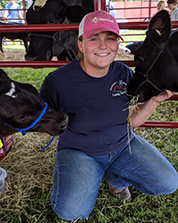
As in most places around the United States, this summer has been dreadfully hot, humid, and dry for us. The drought has taken its toll on animals, humans, crops, and all things in between. The cattle are bunched up in barns, pastures, and anywhere there is shade to escape the unforgiving heat. These pile-ups lead to mud holes just from stomping around in the same spot and using the bathroom. These mud holes are breeding ground for bacteria and flies and can lead to cows developing a mammary infection known as coliform mastitis, which can be deadly if not managed or handled properly.
We ended up with three cases of coliform, and in every instant, the cows dried up and are now awaiting the withdrawal period of their treatment to end. One of these cows was supposed to go dry right away but became ill the day before. With no other choice, we left her with the milk herd in order to treat her properly. However, after a week and a half, she decided her calf needed to come 40 days out from her due date.
In coliform cases, it’s not too abnormal for cows to abort. The toll the coliform takes on the cow’s body and udder is so hard that they have to rid themselves of anything causing them any additional stress — in this case, the calf. Dad caught her calving early, and we ended up putting her in the working pen to help her deliver it. When the calf came out, we expected it to be dead, but the calf was breathing and alive. We couldn’t believe it. We got her cleaned up and sitting up. The cow rejected the calf immediately; she didn’t have a bond due to being sick. So, our biggest question now was how to feed the calf. She was too weak for a normal bucket, so we improvised and only used a small esophageal feeder when absolutely necessary.
For the five days we had Violet, I spent every day moving her legs and teaching her to stand and walk. She always twitched her ear at her name and would bellow out when we were near. She was a miracle calf that our 10-month-old black lab took to immediately. Our pup would cuddle up with Violet and lick her nose and make sure she was okay. She adopted Violet and always made sure she was fine. It was an astonishing sight to see two opposites respond so well and see such a small calf stand and walk. It was a sight to be seen.
Violet was born too early, but we were determined to give her the same chance as all the other calves. We fed her, I did physical therapy with her twice a day, and we loved her like all the others. We knew she probably wouldn’t make it due to developmental problems that were bound to arise without our knowledge, but we gave her a shot.
Violet taught us patience and understanding. She gave us a chance and we gave her one. Her mother couldn’t handle her, so we took her on and raised her until the end. Five days may not seem like much, but it was a life experience I’ll never forget. Stay safe out there, folks.

The author is a sixth-generation farmer and fifth-generation dairy producer in southwest Virginia, where she and her family own and operate a 145-head Holstein dairy. Courtney is involved in agriculture organizations throughout her community and is a graduate of Virginia Tech.








